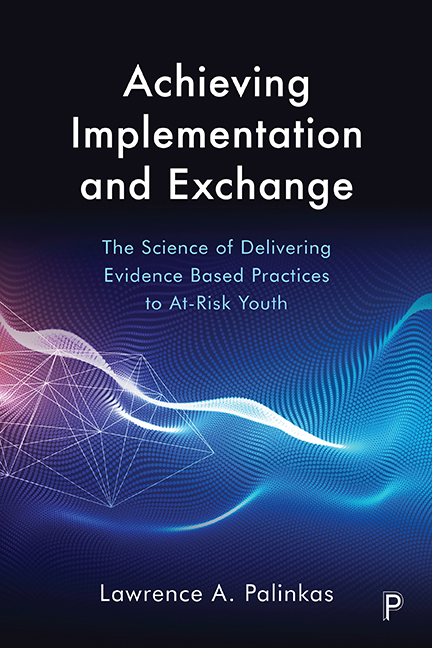 Achieving Implementation and Exchange
Achieving Implementation and Exchange Book contents
- Frontmatter
- Dedication
- Contents
- Tables and figures
- Abbreviations
- Preface
- 1 Introduction
- 2 The need for evidence-based practice
- 3 Understanding and reducing the gap
- 4 EBP implementation in child welfare and child mental health
- 5 Social networks and EBP implementation
- 6 Use of research evidence and EBP implementation
- 7 Local models of EBP implementation
- 8 Research–practice–policy partnerships
- 9 Cultural exchange and EBP implementation
- 10 A transactional model of implementing EBP
- References
- Index
8 - Research–practice–policy partnerships
Published online by Cambridge University Press: 13 April 2022
- Frontmatter
- Dedication
- Contents
- Tables and figures
- Abbreviations
- Preface
- 1 Introduction
- 2 The need for evidence-based practice
- 3 Understanding and reducing the gap
- 4 EBP implementation in child welfare and child mental health
- 5 Social networks and EBP implementation
- 6 Use of research evidence and EBP implementation
- 7 Local models of EBP implementation
- 8 Research–practice–policy partnerships
- 9 Cultural exchange and EBP implementation
- 10 A transactional model of implementing EBP
- References
- Index
Summary
It serves us because we understand the system better and make better policy decisions, and it helps them because they get to showcase their skills and publish things and get more grants and stuff. So it is a mutually beneficial process. I think what has happened with all of the systems change over the last year or two years is that the relationship has gone from mutually beneficial to symbiotic and absolutely positively critical for doing the work that we do. And the level of reliance is just skyrocketed exponentially and the partnership is more like closely intertwined than what it was previously…So people that you can rely on, that you can trust, that get it, that can be responsive to your needs real quickly and that can help you carry on the vision that you need to achieve in a short period of time, of having them as our partnership has been extremely beneficial, more so now than ever. (Policymaker, New York State)
In Chapter Five, the role of social influence networks in implementing EBPs was highlighted. These networks included staff members of one's own organization as well as peers working in other organizations in the same jurisdiction (that is, county) or in other jurisdictions. In the case of the CAL-OH study, the networks also included researchers who developed the EBP (TFCO) and the implementation strategy (CDT) and who assessed the effectiveness of the implementation strategy in scaling up the EBP. However, the specific role of these researchers was not addressed in the CAL-OH study, but rather was viewed implicitly.
In Chapters Six and Seven, two different models of evidence and implementation were introduced: a global model that is external to most settings, scientifically rigorous and generalizable across different settings; and a local model that is internal and originates within an agency or jurisdiction, based on personal experience, and specific to the needs of an organization and the community it serves. Global models typically represent the cultural understandings of researchers, while local models typically represent the shared understandings or cultural systems of practitioners and policymakers. However, there is little understanding of how these two models operate in tandem when researchers and practitioners/policymakers work together to implement an EBP.
- Type
- Chapter
- Information
- Achieving Implementation and ExchangeThe Science of Delivering Evidence-Based Practices to At-Risk Youth, pp. 139 - 168Publisher: Bristol University PressPrint publication year: 2018


